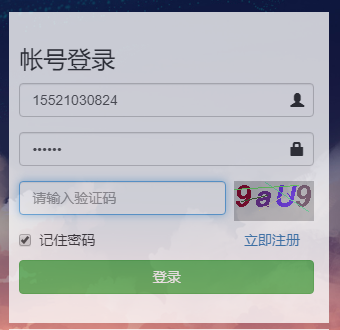一、编写验证码工具类
package yaq.util;
import java.awt.*;
import java.awt.image.BufferedImage;
import java.util.Random;
/**
* @author scy 2018/9/4
*/
public class VerifyUtil {
/**验证码字符集*/
private static final char[] chars = {
'0', '1', '2', '3', '4', '5', '6', '7', '8', '9',
'a', 'b', 'c', 'd', 'e', 'f', 'g', 'h', 'i', 'j', 'k', 'l', 'm', 'n',
'o', 'p', 'q', 'r', 's', 't', 'u', 'v', 'w', 'x', 'y', 'z',
'A', 'B', 'C', 'D', 'E', 'F', 'G', 'H', 'I', 'J', 'K', 'L', 'M', 'N',
'O', 'P', 'Q', 'R', 'S', 'T', 'U', 'V', 'W', 'X', 'Y', 'Z'};
/**字符数量*/
private static final int SIZE = 4;
/**干扰线数量*/
private static final int LINES = 5;
/**宽度*/
private static final int WIDTH = 80;
/**高度*/
private static final int HEIGHT = 40;
/**字体大小*/
private static final int FONT_SIZE = 30;
/**
* 生成随机验证码及图片
* Object[0]:验证码字符串;
* Object[1]:验证码图片。
*/
public static Object[] createImage() {
StringBuffer sb = new StringBuffer();
// 1.创建空白图片
BufferedImage image = new BufferedImage(
WIDTH, HEIGHT, BufferedImage.TYPE_INT_RGB);
// 2.获取图片画笔
Graphics graphic = image.getGraphics();
// 3.设置画笔颜色
graphic.setColor(Color.LIGHT_GRAY);
// 4.绘制矩形背景
graphic.fillRect(0, 0, WIDTH, HEIGHT);
// 5.画随机字符
Random ran = new Random();
for (int i = 0; i <SIZE; i++) {
// 取随机字符索引
int n = ran.nextInt(chars.length);
// 设置随机颜色
graphic.setColor(getRandomColor());
// 设置字体大小
graphic.setFont(new Font(
null, Font.BOLD + Font.ITALIC, FONT_SIZE));
// 画字符
graphic.drawString(
chars[n] + "", i * WIDTH / SIZE, HEIGHT*2/3);
// 记录字符
sb.append(chars[n]);
}
// 6.画干扰线
for (int i = 0; i < LINES; i++) {
// 设置随机颜色
graphic.setColor(getRandomColor());
// 随机画线
graphic.drawLine(ran.nextInt(WIDTH), ran.nextInt(HEIGHT),
ran.nextInt(WIDTH), ran.nextInt(HEIGHT));
}
// 7.返回验证码和图片
return new Object[]{sb.toString(), image};
}
/**
* 随机取色
*/
public static Color getRandomColor() {
Random ran = new Random();
Color color = new Color(ran.nextInt(256),
ran.nextInt(256), ran.nextInt(256));
return color;
}
}
二、controller层使用
/**
* 登录
*/
@RequestMapping("/login")
@ResponseBody
public Map<String,Boolean> handleLoginByArticleDetail(String userId, String password, String captcha, boolean check, HttpServletResponse response, HttpSession session) {
Map<String,Boolean> map=new HashMap<>();
//得到验证码
String imageCode = (String) session.getAttribute("imageCode");
boolean isLogin=false;
//校验验证码
if(!imageCode.equals(captcha)){
map.put("isCaptcha",false);
}else{
map.put("isCaptcha",true);
//判断数据库是否存在该用户
isLogin=userService.isUserExit(userId, password);
}
map.put("isLogin",isLogin);
if (isLogin) {
//处理登录
}
return map;
}
@ApiOperation("生成验证码")
@GetMapping("getCode")
public void getCode(HttpServletResponse response, HttpSession session) throws Exception{
//利用图片工具生成图片
//第一个参数是生成的验证码,第二个参数是生成的图片
Object[] objs = VerifyUtil.createImage();
//将验证码存入Session
session.setAttribute("imageCode",objs[0]);
//将图片输出给浏览器
BufferedImage image = (BufferedImage) objs[1];
response.setContentType("image/png");
OutputStream os = response.getOutputStream();
ImageIO.write(image, "png", os);
}
三、表单代码
<form role="form" id="form" action="#" method="post" enctype="multipart/form-data" onsubmit="return false">
<div>
<h3 style="position: center">帐号登录</h3>
</div>
<div class="form-group has-feedback">
<span class="glyphicon glyphicon-user form-control-feedback"></span>
<input type="text" class="form-control" name="userId" id="phoneForL" placeholder="请输入手机号码" value="${userId1}" required/>
</div>
<div class="form-group has-feedback">
<span class=" glyphicon glyphicon-lock form-control-feedback"></span>
<input type="password" class="form-control" name="password" id="pswForL" placeholder="请输入密码" value="${password}" required/>
</div>
<div class="form-group has-feedback">
<input type="text" class="form-control" id="captchaForL1" placeholder="请输入验证码" style="width: 70%;display: inline;">
<img id="loginform:vCode1" src="/getCode" style="display:inline;float: right;" title="看不清?点击换一张试试" onclick="javascript:document.getElementById('loginform:vCode1').src='/getCode?'+Math.random();"/>
</div>
<div class="checkbox">
<label><input type="checkbox" name="check" checked title="选中后可保存密码,七天内直接登录"/>记住密码</label>
<a data-toggle="modal" data-target="#register" href="" style="margin-left:145px">立即注册</a>
</div>
<input type="hidden" name="type" value="1">
<button type="button" class="btn btn-default btn-success btn-block" onclick="login('phoneForL','pswForL','captchaForL1',1)">登录</button>
</form>
四、login.js(用了ajax)
function login(userIdID, pswID, captchaID, type) {
var userId = document.getElementById(userIdID).value;
var password = document.getElementById(pswID).value;
var captcha = document.getElementById(captchaID).value;
if (userId.length <= 0) {
document.getElementById(userIdID).focus();
return;
} else if (password.length <= 0) {
document.getElementById(pswID).focus();
return;
} else if (captcha.length <= 0) {
document.getElementById(captchaID).focus();
return;
}
var check = false;
check = document.getElementsByName("check")[0].checked;
$.ajax({
type: "post",
url: "/login",
dataType: "json",
data: {
userId: userId,
password: password,
captcha: captcha,
check: check
},
cache: false,
success: function (result) {
if (result["isLogin"]) {
alert("登陆成功");
} else {
var message = (result["isCaptcha"] ? "账号或密码错误" : "验证码错误");
alert(message);
if (result["isCaptcha"]) {
document.getElementById("phoneForL").focus();
//刷新验证码
document.getElementById("loginform:vCode1").click();
} else {
document.getElementById("captchaForL1").focus();
}
}
},
error: function () {
alert("出现异常");
}
});
}
五、页面展示

参考链接:http://www.cnblogs.com/thcy1314/p/9585268.html























 1544
1544











 被折叠的 条评论
为什么被折叠?
被折叠的 条评论
为什么被折叠?










